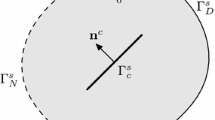Abstract
A finite-element-based method is proposed to accommodate the arbitrary motion of a crack under general two-dimensional configurations of loading and body geometry. The primary goal is to render consistently accurate simulations of crack propagation, while maintaining a high degree of computational efficiency and without a significant extra burden on the analyst. The essence of the method, here called the Arbitrary Local Mesh Replacement method, is the replacement of the finite element interpolant in the vicinity of the crack tip with one that is derived from a moving mesh patch. The boundary of the patch is not required to be coincident with background-mesh element edges. Accordingly, a weak statement of compatibility is enforced on the interface between the two meshes, thereby introducing a small set of additional, force-type unknowns. Also, partial elements are manifest near the patch boundary; a special numerical integration rule is devised for their treatment.
Similar content being viewed by others
Author information
Authors and Affiliations
Rights and permissions
About this article
Cite this article
Rashid, M. A computational procedure for simulation of crack advance in arbitrary two-dimensional domains. Computational Mechanics 20, 133–138 (1997). https://doi.org/10.1007/s004660050229
Published:
Issue Date:
DOI: https://doi.org/10.1007/s004660050229




